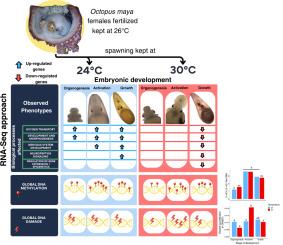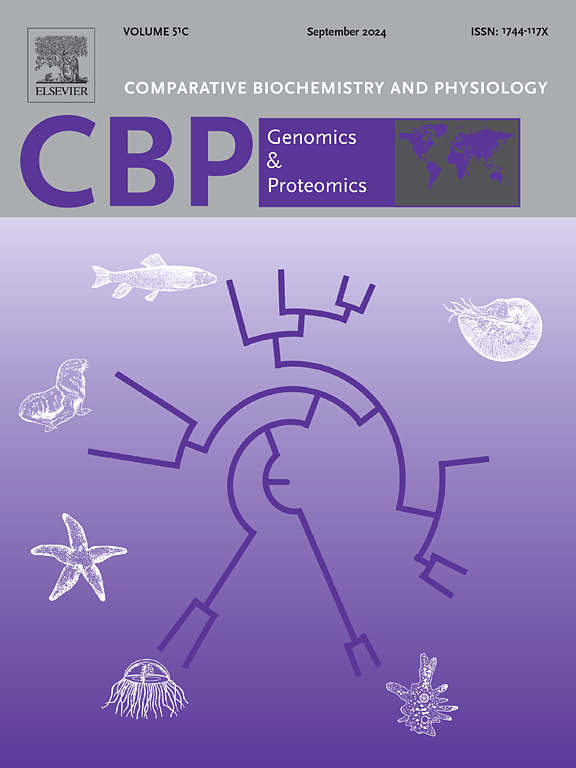Chronic thermal stress on Octopus maya embryos down-regulates epigenome-related genes and those involved in the nervous system development and morphogenesis
IF 2.2
2区 生物学
Q4 BIOCHEMISTRY & MOLECULAR BIOLOGY
Comparative Biochemistry and Physiology D-Genomics & Proteomics
Pub Date : 2024-09-28
DOI:10.1016/j.cbd.2024.101332
引用次数: 0
Abstract
Red Octopus maya is strongly influenced by temperature. Recent studies have reported negative reproduction effects on males and females when exposed to temperatures higher than 27 °C. Embryos under thermal stress show morphological and physiological alterations; similar phenotypes have been reported in embryos from stressed females, evidencing transgenerational consequences. Transcriptomic profiles were characterized along embryo development during normal-under thermal stress and epigenetic alterations through DNA methylation and damage quantification. Total RNA in organogenesis, activation, and growth stages in control and thermal stress were sequenced with Illumina RNA-Seq. Similarly, total DNA was used for DNA methylation and damage quantification between temperatures and embryo stages. Differential gene expression analyses showed that embryos express genes associated with oxygen transport, morphogenesis, nervous system, neuroendocrine cell differentiation, spermatogenesis, and male sex differentiation. Conversely, embryos turn off genes involved mainly in nervous system development, morphogenesis, and gene expression regulation when exposed to thermal stress – consistent with O. maya embryo phenotypes showing abnormal arms, eyes, and body development. No significant differences were observed in quantifying DNA methylation between temperatures but they were for DNA damage quantification. Epigenetic alterations are hypothesized to occur since several genes found downregulated belong to the epigenetic machinery but at histone tail level.

章鱼玛雅胚胎的慢性热应激会下调表观基因组相关基因以及参与神经系统发育和形态发生的基因。
红章鱼玛雅深受温度影响。最近的研究报告称,当温度高于 27 °C时,雌雄章鱼的繁殖都会受到负面影响。受热胁迫的胚胎会出现形态和生理变化;受胁迫的雌性胚胎也会出现类似的表型,这证明了代代相传的后果。通过DNA甲基化和损伤定量分析,研究了胚胎在正常和热应力下发育过程中的转录组特征以及表观遗传学改变。利用Illumina RNA-Seq对对照组和热胁迫组胚胎器官形成、活化和生长阶段的总RNA进行测序。同样,对不同温度和胚胎阶段的总 DNA 进行了 DNA 甲基化和损伤定量分析。差异基因表达分析表明,胚胎表达与氧运输、形态发生、神经系统、神经内分泌细胞分化、精子形成和雄性分化相关的基因。相反,当暴露于热应激时,胚胎会关闭主要涉及神经系统发育、形态发生和基因表达调控的基因,这与 O. maya 胚胎表现出的手臂、眼睛和身体发育异常相一致。在对不同温度下的 DNA 甲基化进行定量时没有观察到明显差异,但在对 DNA 损伤进行定量时却有明显差异。由于发现的几个基因属于表观遗传机制,但属于组蛋白尾水平,因此假设发生了表观遗传改变。
本文章由计算机程序翻译,如有差异,请以英文原文为准。
求助全文
约1分钟内获得全文
求助全文
来源期刊
CiteScore
5.10
自引率
3.30%
发文量
69
审稿时长
33 days
期刊介绍:
Comparative Biochemistry & Physiology (CBP) publishes papers in comparative, environmental and evolutionary physiology.
Part D: Genomics and Proteomics (CBPD), focuses on “omics” approaches to physiology, including comparative and functional genomics, metagenomics, transcriptomics, proteomics, metabolomics, and lipidomics. Most studies employ “omics” and/or system biology to test specific hypotheses about molecular and biochemical mechanisms underlying physiological responses to the environment. We encourage papers that address fundamental questions in comparative physiology and biochemistry rather than studies with a focus that is purely technical, methodological or descriptive in nature.

 求助内容:
求助内容: 应助结果提醒方式:
应助结果提醒方式:


